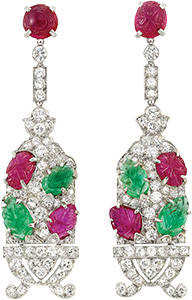|
Legacy
East Meets West For High Art
Tutti frutti jewelry offered an exotic alternative that continues to attract admirers — and soaring auction prices — today.
By Phyllis Schiller

|
| Art Deco diamond, emerald and ruby platinum-set tutti frutti pendant earclips designed as a diamond-set flower basket filled with a bouquet of engraved leaf and blossom gemstones. Cartier, circa 1925; photo courtesy Doyle.
|
A magical melding of East and West, tutti frutti jewelry artfully incorporated the textural colored gemstones of Mogul jewelry into a variation on the Art Deco theme, introduced by Cartier at the Paris exposition of 1925. The rich and fashion-forward of the day gravitated to this exuberant style, decorated with what were called pierres de couleur or colored stones. The term “tutti frutti” was coined later, believed to be based on the colorful costume worn by Carmen Miranda when she sang “The Lady in the Tutti Frutti Hat” in the 1943 movie, “The Gang’s All Here.”
As the popularity of the style increased, so did the number of makers, including Van Cleef & Arpels and Mauboussin, points out Janet Levy, principal, J. & S.S. DeYoung, Inc., New York City. In America, Raymond C. Yard and Charlton & Co., among others, made fine jewels in this style. “Tutti frutti became a style that appealed to jewelers,” says jewelry historian Janet Zapata. But, she says, “Cartier did it best.”
In 1901, Pierre Cartier was commissioned by Queen Alexandra of England to design a necklace for her to wear with three Indian gowns that she had received as a gift from Mary Curzon, the wife of the Viceroy of India. In 1911, a trip to India introduced Jacques Cartier, who oversaw the firm’s London branch, to the beauty of Mogul jewelry’s richly hued engraved rubies and emeralds in the shapes of leaves, blossoms and berries. And the rest is jewelry design history.
“After the First World War, people were ready to enjoy themselves during the Roaring Twenties,” explains Levy, who says most of the tutti frutti jewelry she sees dates from 1925 to 1930. “During this period, Indian maharajahs were traveling to Paris to have their jewels refashioned. This inspired Cartier and other jewelers to create new pieces using carved rubies and emeralds in vibrant and expressive designs.”
Ann Lange, senior vice president, executive director, jewelry department, Doyle New York, points out, “The Indian custom was that when you pass jewelry down to the next generation, you remake it. And this is how Cartier started working with the carved colored stones.”
Before tutti frutti, continues Lange, jewelry was very geometric and more predictable in design. “This new style had a certain exoticism. It represented a little bit of a rebellion. The combination and cut of the gems made an impact, adding another dimension.”
“Worn by very wealthy, very stylish women, the tutti frutti jewelry always had a cachet, it made a statement,” says Zapata. It was something different from the very flat and rectilinear early Art Deco. “There are colored gemstones that are leaves, berries, etc., that give it a dimensionality and a different color palette than what had gone before.”
In addition to an exuberant use of color, says Carol Elkins, senior vice president, Sotheby’s jewelry department, it is the artful designs of these multigem jewels, along with the excellent craftsmanship, that make the style so desired by collectors today. “No two are alike. The layouts for the bracelets were meticulously worked on, painstakingly for hours at a time. The variations in color schemes — whether predominantly rubies and emeralds, or a combination of rubies, sapphires, emeralds and onyx — each has its own appeal. The patterns and motifs drew upon a rich heritage of Indian and Far Eastern design elements from centuries past. These jewels are symbols of status and refined taste.”
Most descriptions of the stones use the word “carved,” but, explains Zapata, “they are engraved, the gems chosen more for their hues than value.” It’s not the sum of the parts but the artistry of the whole that give them their worth, in the same way paint and canvas don’t command millions until used by a master to create a work of art.
The popularity of this jewelry has continued through the decades and people are willing to pay a premium price to own it. At Sotheby’s New York in 2014, Evelyn Lauder’s Cartier tutti frutti bracelet achieved a record $2.1 million. This past April, a pair of Art Deco tutti frutti earclips by Cartier, shown right, sold for $185,000 at Doyle New York, more than three times the presale high estimate.
“The prices have certainly been amazing,” says Lange. One reason, she says, is there’s not that much of this jewelry around. “Most of the pieces we’ve seen lately have been held in families. And what motivates buyers to such a degree is that they’re fresh to the market. Moreover, the rarity and importance of the Cartier name significantly increases value and attracts global interest.”
Cartier tutti frutti jewels do not appear in the market very often, points out Elkins. “A finite number were made, while the number of newly minted billionaires seeking such treasures seems to be ever increasing. When comparing prices fetched for certain categories of paintings, these rare jewels would seem undervalued.”
“Whenever we get tutti frutti jewelry,” says Levy, “we’re always excited about it. The intricacy of the design pulls you in. It’s really a high art form.”
It’s an ageless style, sums up Zapata. “It will always have appeal. Fifty years from now, whatever the prices are today, add another zero.”Article from the Rapaport Magazine - November 2015. To subscribe click here.
|
|